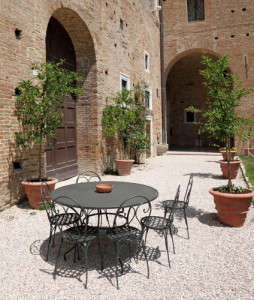 You've decided to make your new home as ecologically sustainable as possible. You've changed out the toilets for low-flow versions and added insulation, installed bamboo flooring, energy-efficient windows and natural gas appliances. Now, it's time to tackle the yard. Before you tear out that water-guzzling turf, make a plan to replace it with an aesthetically pleasing low-maintenance xeriscape.
You've decided to make your new home as ecologically sustainable as possible. You've changed out the toilets for low-flow versions and added insulation, installed bamboo flooring, energy-efficient windows and natural gas appliances. Now, it's time to tackle the yard. Before you tear out that water-guzzling turf, make a plan to replace it with an aesthetically pleasing low-maintenance xeriscape.
Dry-scaping, desert-scaping, or xeriscaping, is landscaping that serves to utilize less water, conserve energy and protect the local environment and wildlife. That doesn't mean you have to replace everything with sand and cacti though. Most climates support a variety of plant life, so just be sure to select regionally native plants. Here are some ideas to get you started.
Functionality
Lawns offer play and activity space, so if you use your yard (children's playground, entertainment, extension of living area), be careful to use materials and designs that enhance—rather than diminish—the usefulness of your landscape. For example, replacing turf with coarse gravel would not work for a play area. Instead, use pea gravel, sand, mulch or recycled materials especially designed for playground use.
Create entertainment areas with paver stones, gravel or an artful combination. For some great ideas, check out these images.
Site Planning
Before installing your xeriscape, take time to determine how water, wind, shade and sun factor into your yard. If your property is on a slope (even a slight change in elevation), determine how water naturally flows. Avoid placing a playground or entertainment area at the lowest point where water might pool—reserve that area for plants. Preserve existing trees and install shade-tolerant plants in their shadow. Consider heavier ground cover (lava rock, larger gravel, native plants) for areas exposed to wind to prevent erosion.
Maintenance
The advantages of no lawn to mow can quickly be overshadowed if your xeriscape becomes a haven for weeds. Before spraying weed-killer, however, check local requirements for herbicides that work best and are safe for the local environment. Cover the bare soil with landscaping fabric that is water permeable and use garden staples or heavier stones to hold it in place. Layer your gravel or mulch over the fabric making sure it is completely covered. On the other hand, a better option is to use at least 4 inches of mulch. Do not use plastic sheeting under your gravel or mulch: Water will run off, your ground cover will slide around, and you'll just be adding to future landfill.
Conservation
Consult with a landscaper or local gardening shop for the best plants to add to your xeriscape to conserve water and soil. If plants might require added water during very dry seasons, install a drip-irrigation system that adds water slowly and directly at the plant site. Drip-irrigation reduces waste compared to sprinklers and prevents both overwatering and evaporation.
Alternative Materials
Natural landscaping materials such as mulch and gravel may be enhanced by the use of alternatives such as re-purposed rubber tires for playground areas, recycled concrete and brick for rock garden and retaining walls, and tumbled glass "mulch" to add color to raised beds and decorative pathways.
Compliments of Virtual Results.